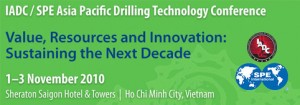Panel discussion: Maximizing profitability through competency, talent retention
 Competency, collaboration, certification and talent retention were mentioned as ways to create synergies that maximize profitability during a panel session at the 2010 IADC/SPE Asia Pacific Drilling Technology Conference, 1-3 November in Ho Chi Minh City, Vietnam. The four panelists represented Schlumberger, Weatherford International, Premier Oil and Baker Hughes.
Competency, collaboration, certification and talent retention were mentioned as ways to create synergies that maximize profitability during a panel session at the 2010 IADC/SPE Asia Pacific Drilling Technology Conference, 1-3 November in Ho Chi Minh City, Vietnam. The four panelists represented Schlumberger, Weatherford International, Premier Oil and Baker Hughes.
The first panelist, Graeme Dawson, Schlumberger drilling engineering manager, East Asia, discussed how teamwork among several companies helped the project team to achieve a world-record well on the Al-Shaheen field offshore Qatar by drilling a 35,770-ft horizontal section.
Although technological developments – in geosteering and rotary steerables, for example – helped to enable this drilling record, personnel competency was also a critically important element to the project’s success and operational efficiency, Mr Dawson said. To ensure that people actually understood what they were doing instead of doing things by rote, a full competency system was developed for the project. A list of core subjects was created, and everyone’s level of understanding within each element was determined.
A competency analysis was then performed looking at “what they do know and what they should know for the job they’re trying to achieve,” he said. Coaches and mentors were assigned, and personal training development plans were created.
Alistair Geddes, vice president Asia Pacific for Weatherford International, urged industry to spend more time fine-tuning the collaborative relationship between operators and the service sector. Considering the myriad challenges the industry faces with unconventionals, extreme environments, etc, having the right level of collaboration in this relationship is key.
“Are we truly collaborating and identifying what the next technology requirements are?” Mr Geddes asked. “(Service companies) are not developing technology for technology’s sake. We don’t want to develop technology that isn’t used… We want to develop technologies that can actually impact the challenges that the operating community has.”
Mr Geddes looked at five levels of an operator/service company relationship alignment. At the bottom level, a service company simply supplies something, whether it’s equipment or services (cost-based relationship). On the next level, the service company serves the operator (rate-based relationship). Next it’s integrate (performance-based relationship), then solve (results-based relationship). Finally, at the top level, the service company is a partner to the operator (value-based relationship).
“Different clients have different drivers,” Mr Geddes said. “Do we spend enough time defining the relationship? It’s too easy to get into a relationship, whether it’s from an expectations perspective or a commercial perspective, where the drivers are not truly aligned. I think that’s fundamental.”
The third panelist, Tim Hanson, global drilling manager for Premier Oil, first discussed his company’s accredited management systems, then urged drilling contractors to take a closer look at their own management systems and their adherence to these systems.
In particular, Mr Hanson urged drilling contractors to pay more attention to the certification and recertification of their rig equipment. He noted that Premier Oil contracted six rigs over the past 18 months – two in the UK North Sea and one each in Norway, Congo, Vietnam and Indonesia. “Four out of six BOPs did not meet API specs. Three of those BOPS had shear rams that did not meet API specs. If we had a well control incident, we potentially might not have been able to control that well,” Mr Hanson said.
He added that, recently on a drillship, shear rams could not sever the drill pipe during acceptance testing because the BOP manufacturer’s latest updates on those shear rams had not been adopted.
The final panelist, Andrew Shaw, vice president and managing director, Southeast Asia, Baker Hughes, focused on the immense challenge the industry faces in managing human resources due to extreme market volatility.
Analyzing the growth in employees for six large oilfield service companies from 2004 through 2008, he noted that most of the increase came from hiring new people rather than mergers and acquisitions. Together, these six companies hired 112,000 employees over that five-year period, increasing their workforce by 64%.
“In 2009, the same six companies had to reduce their workforces by more than 8% – huge staff reductions by around 23,000 people,” Mr Shaw said. “The ability to react and accommodate activity cycles of this magnitude, investment, capital spending, technology development, personnel and competency are all at risk.”
Mr Shaw concluded: “I believe that retaining talent in our industry is probably the single most important thing we have to achieve if we’re to have long-term success.”




